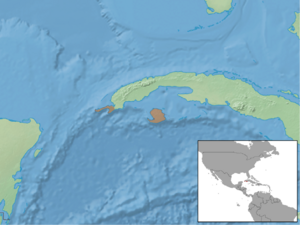Cuban greater funnel-eared bat facts for kids
The Cuban greater funnel-eared bat (Natalus primus) is a special type of funnel-eared bat. This bat is found only in one cave in western Cuba. It was once thought to be extinct, but a living group was found in 1992.
Quick facts for kids Cuban greater funnel-eared bat |
|
|---|---|
| Conservation status | |
| Scientific classification | |
| Genus: |
Natalus
|
| Species: |
primus
|
 |
|
Contents
What Does This Bat Look Like?
The Cuban greater funnel-eared bat has ears shaped like funnels. Its tail is as long as its head and body put together. Its legs are shorter than its forearm.
Fur and Hair
The hair on its back is about 8 to 9 millimeters long. The hair on its belly is about 7 to 8 millimeters long. Each hair has three color bands. It is dark at the bottom, lighter in the middle, and a bit darker at the tip. These bats have stiff, black hairs above their upper lip, like a tiny mustache. They also have white hairs below their lower lip. Their fur is tan and reddish-brown, and their belly is lighter in color.
What Do They Eat?
These bats mostly eat insects. Their diet includes moths, crickets, and beetles.
Where Do They Live?
In 1992, a living group of these bats was found in a cave called Cueva La Barca. This cave is on Isla de la Juventud island. Scientists believe that strong hurricanes long ago might have made these bats start living only in caves.
Why Are These Bats Important?
When the Cuban greater funnel-eared bat was first described in 1919, scientists thought it was extinct. This was because they only found fossils of it. These fossils were found in Cuba, on Isla de la Juventud, Grand Cayman, and some islands in the Bahamas.
Rediscovery and Status
Luckily, a living group was found in 1992. Today, the Cuban greater funnel-eared bat is considered a vulnerable species. This means it is at risk of becoming extinct. It lives in only one cave, Cueva La Barca.
Threats to Their Survival
Even though there are many bats in that one cave, the species could still disappear. This is because they do not spread out to other places. People disturbing their cave and losing their natural home are big problems. It is thought that only a few thousand of these bats are left.
The number of these bats has gone down in most parts of Cuba. This decline might still be happening. Losing forests and changes to caves are big threats to Cuban bats. The roof of their cave is slowly falling apart. This could change the temperature inside the cave, which would be bad for the bats. Protecting these cave-dwelling bats in Cuba needs teamwork. It means doing more research and taking care of their homes.
See also
 In Spanish: Murciélago de orejas de embudo cubano para niños
In Spanish: Murciélago de orejas de embudo cubano para niños


